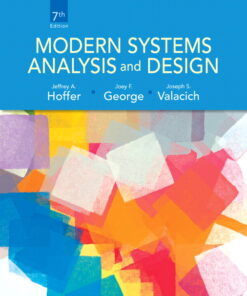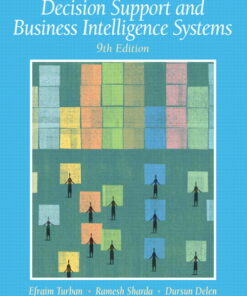Solution Manual for Exceptional Learners: An Introduction to Special Education 14th Edition
$35.00
Solution Manual for Exceptional Learners: An Introduction to Special Education 14th Edition
You will receive this product immediate after placing the order
Chapter 1: Exceptionality and Special Education
- Getting Oriented to Exceptional Learners and Special Education
The study of exceptionality is the study of differences and similarities among learners. Exceptional learners are different in some way from the average, but are not different from the average in every way. In fact, most exceptional learners are average in more ways than they are exceptional. There are many ambiguities in special education because there is no one accepted theory of normal development.
It is important that we recognize people’s abilities and not allow their disabilities to become the complete focus of concern. The distinction between a disability and a handicap is a significant consideration for working and living effectively with persons with exceptionalities. A disability is an inability to do something whereas a handicap is a limitation that is imposed on someone. Another important distinction is between inability and disability. Although all disabilities are an inability to do something, not all inabilities are disabilities. A disability is an inability to do something that most people who have typical maturation, opportunity, or instruction can do.
Key Terms:
Exceptional learner
Disability
Handicap
Inability
Discussion Points:
- Share Richard Hungerford’s classic editorial, “On Locusts” (American Journal of Mental Deficiency, 1950, 54, 415–418) or excerpts from it with your students. Ask students to evaluate Hungerford’s commentary on sameness and difference in intellectual disability.
- Discuss ways in which a disability is similar to and different from a handicap: have students list ways they themselves may be described as having handicaps.
- Discuss the importance of using People First language throughout the course and beyond, including in any written assignments and during group activities and discussions. Have the students complete the People First Language Discussion Activity in class. To locate this activity, visit https://iris.peabody.vanderbilt.edu/wp-content/uploads/pdf_activities/group/IA_People_First_Language.pdf
Lecture Ideas:
- Emphasize the examples given in the text to illustrate the concepts of “disability” and “handicap.” Blindness is a disability that is not a handicap in the dark; using a wheelchair is not a handicap unless there are no ramps or other features of accessibility. Some students will need more examples and non-examples to really understand how the concepts differ.
- Check for student understanding of the concept of disability versus inability by having them provide more examples than those given in the (e.g., a 70-year-old who cannot run 10 miles but who can walk with ease does not have a disability).
- Describe the language we use to talk about persons with disabilities (e.g., disability vs. handicap, person-first language as in “child with learning disabilities” rather than “learning disabled child”). Provide examples of earlier writings that use terms that, today, might be considered derogatory. Ask students to comment on how language may be important to changing the stereotyped images of persons with disabilities.
Activity 1.1 Disabilities in the Popular Press
Have students locate stories about people with disabilities in the popular press (internet and magazines). Working in small groups, have students analyze the stories to determine the author’s or characters’ perspectives: are peoples’ abilities stressed as much as their disabilities? Are they portrayed as being handicapped?
- Educational Definition of Exceptional Learners
For educational purposes, exceptional learners are those who require special education and related services if they are to reach their full human potential. Learners who require special education are markedly different from most students in their sensory, physical, cognitive, emotional, and/or communication abilities. Moreover, exceptional learners require special education when special needs created by the disabling condition cannot be met in the regular educational program.
Discussion Points:
- Discuss why it would be impossible to present an individual as an example of the definition of exceptionality.
- Note that teachers may have disabilities. What are the possible advantages and disadvantages of teachers and their students having the same exceptionality? Press students to explore this question in different categories of exceptionality.
Lecture Ideas:
- Ask students to identify ways that special education services help children with disabilities. Make a list on the board as students provide ideas.
- Ask students to hypothesize about the educational and future outcomes of a child whose disability is overlooked or not addressed in school for some reason.
Activity 1.2 Movies/TV Series Featuring Individuals with Disabilities
Ask students to identify movies or TV series they have seen in which an individual with a disability was featured (e.g., I am Sam, Children of a Lesser God, Mask, My Left Foot, Nell, The Other Sister, Rain Man, What’s Eating Gilbert Grape?, Atypical, The Bridge, Alphas, Covert Affairs, Switched at Birth). Use these films to highlight similarities and differences (1) among characteristics of specific disabilities, (2) among persons with disabilities and persons without disabilities, and (3) among the needs of persons with specific disabilities.
III. Prevalence of Exceptional Learners
Approximately 8-9 in every 100 students between the ages of 6 to 21 years are identified as exceptional and receive special education services. Although special education serves children from preschool age to youths of 18 to 21 years, the majority of those receiving special education services are between the ages of 6 and 17. Therefore the proportion for this last age range is actually 10+ in every 100 students. The task of determining the number of students who have exceptionalities is influenced by many factors that make accurate estimates difficult to establish. Some disabilities occur with a relatively high frequency (e.g., learning disabilities, communication disorders, emotional or behavioral disorders). These categories are often referred to as high-incidence disabilities. Other disabilities occur with a relatively low frequency (e.g., blindness, deafness, deaf-blindness). These categories are often referred to as low-incidence disabilities. Most rates of occurrence of high-incidence disabilities have remained relatively stable; however there have been dramatic increases in some of the low-incidence categories, such as autism spectrum disorder and traumatic brain injury, in the last decade.
Key Terms:
Prevalence
High-incidence disability
Low-incidence disability
Discussion Points:
- Discuss why it is important to determine the number of children and youth who have exceptionalities. Note ways in which the prevalence of disabilities may influence funding for special education.
- Discuss factors that make determining the prevalence of exceptionalities a difficult task.
Lecture Ideas:
- Illustrate the concept of prevalence. Using current estimates of prevalence (8-9 out of every 100 students receive special education), describe how this number translates into the number of students attending your college or the number of students in your class who may have a child who receives special education (or, who may have received it him or herself).
- Although prevalence estimates for each category of special education are provided in subsequent chapters, provide a table with this information now. Using a pie chart will help to illustrate how many students from the total population of children receiving special education services fall within a certain category.
Activity 1.3 Importance of Prevalence Estimates
Ask students to assume the roles of administrators, legislators, or parent advocates who are planning programs or appealing for funding and to note the importance of prevalence estimates in their thinking.
Activity 1.4 Prevalence Estimates in the Popular Press
Have students locate current publication pieces in popular press that discuss the rise or fall in specific disability categories and ask them to identify causes attributed to the rise or fall (this should be fairly easy for autism spectrum disorder and ADHD).
Activity 1.5 Trends in Prevalence Data
Have students go to the U. S. Department of Education’s website (https://www2.ed.gov/about/reports/annual/osep/index.html) that contains several years of Annual Reports to Congress—from 1995 to the most recent. Ask them to pick two or three reports several years apart and pick different age ranges (e.g., 3 to 5 years, 3 to 21 years, 6 to 21 or to 17 years). Have them report on any trends that they discover in the data tables across years and age ranges.
Activity 1.6 Prevalence Rates of Disability Categories: OSEP and NSCH
This activity may be conducted in small groups during class or as an individual homework assignment. Assign students the task from the Iris Center titled Disability Awareness: Prevalence Rates of Disability Categories (https://iris.peabody.vanderbilt.edu/wp-content/uploads/pdf_activities/independent/IA_Prevelance_Rates.pdf). Assign the optional reading below and ask students to discuss reasons why OSEP data varies from NSCH data.
Pullen, P. C. (2016). Prevalence of learning disabilities from parental and professional perspectives: A comparison of the data from the National Surveys of Children’s Health and the Office of Special Education’s Reports to Congress. Journal of Learning Disabilities. DOI: 10.1177/0022219416659447
- Definition of Special Education
Special education refers to specially designed instruction that meets the unique needs of exceptional students. This instruction may include special materials, teaching techniques, equipment, or facilities. In addition, children may require related services to reach their potential; related services may include special transportation, medical treatment, counseling, or occupational therapy. Compared to general education, special education is more precisely controlled—especially in relation to pace, intensity, structure, reinforcement, curriculum, teacher-student ratio, and assessment.
Discussion Points:
- Discuss why the definition of special education is broad: specially designed instruction that meets the unusual needs of an exceptional student. Point out problems that might arise if the definition of special education was more specific or prescriptive.
- Discuss the differences in control (e.g., pace, intensity, structure, reinforcement, curriculum, teacher-student ratio, assessment) between general and special education and how this control is the essence of special education.
Lecture Idea:
- Explain that some school reformers want to do away with special education as a service altogether. They argue that all children should receive the same, high-quality education. Comment on the authors’ claim that “good or reformed general education does not and cannot replace special education for those students at the extremes of the range of disabilities” (p. 8).
Activity 1.7 What Makes Special Education Special?
Have students work in small groups to brainstorm what makes special education “special.” Have each group report to the whole class while you or a student writes their ideas on a large sheet of paper on an overhead slide.
Activity 1.8 Fair Isn’t Always Equal
Have students work is small groups to think of an example that illustrates the idea that “fair is not always equal.” Popular cartoons illustrating this concept can be found at http://www.joebower.org/2011/04/fair-isnt-always-equal.html
and http://jewishspecialneeds.blogspot.com/2013/07/fair-isnt-equal.html
- History and Origins of Special Education
Although there have always been exceptional children and youths, systematic efforts to educate them date back, primarily, to the early 1800s. Most of the early pioneers of special education were European and American physicians who developed techniques to educate children who were blind, deaf, intellectually disabled, or who had emotional or behavioral problems. Today, special education has matured into a profession that is influenced by many disciplines, including psychology, sociology, and social work. Much of the progress that has been made is due to the efforts of professional and parent organizations. These groups have been influential by providing a forum in which those who live or work with children with disabilities may receive support, information, or service.
Legislation pertaining to issues of education of children and youths with disabilities has become increasingly specific and mandatory. However, because the intent of legislation is not always clear, the courts must interpret the legislation to ensure that every learner receives an education appropriate for his or her individual needs. Litigation is typically filed either because special education services are not provided to a child who needs them, or because a child is placed in special education when his or her parents do not want the services. The primary federal law affecting special education is the Individuals with Disabilities Education Act enacted in the 1970s and reauthorized by Congress in 2004. In the twenty-first century, the No Child Left Behind Act (NCLB) was passed and holds implications for the education of exceptional learners. The primary intent of special education laws has been the individual needs of students with disabilities, as incorporated in the Individualized Education Plan (IEP) and the Individual Family Service Plan (IFSP). The Americans with Disabilities Act (ADA) prohibits discrimination against persons with disabilities in employment, transportation, and communications.
Key Terms:
Asylum
Egalitarianism
Nature-nurture
Normalization
Deinstitutionalization
Inclusion
Legislation
Litigation
Individuals with Disabilities Education Act
Individualized Education Plan
Americans with Disabilities Act
Discussion Points:
- Discuss practices or ideas that were introduced early in the history of the field that are still in practice, and some that we no longer use.
- How did the concepts of asylum and egalitarianism affect the treatment of people with disabilities in the past?
- Why do contemporary researchers avoid assigning percentages to genetic and environmental factors affecting intellectual development (the nature-nurture controversy)?
- Discuss ways in which the professional and parent organizations helped shape the direction of special education. Visit the website for the CEC at http://www.cec.sped.org/Membership/Special-Interest-Divisions?sc_lang=en Why are there so many divisions within the organization?
- Discuss the idea that early legislation was permissive; it allowed but did not require programs for exceptional children. Although many states had mandatory legislation requiring special education before 1975, PL 94–142 was the first federal mandatory law.
Discuss how reasonable accommodation in ADA may be as hard to define as appropriate education and least restrictive environment in IDEA. Note that employers are worried about who will decide what is reasonable.
Be the first to review “Solution Manual for Exceptional Learners: An Introduction to Special Education 14th Edition” Cancel reply
Related products
Solution Manual
Solution Manual for Psychology and Life 20th Edition by Gerrig
Solution Manual
Solution Manual for Introduction to Electrodynamics, 4/E 4th
Solution Manual
International Accounting Doupnik 4th Edition Solutions Manual












Reviews
There are no reviews yet.